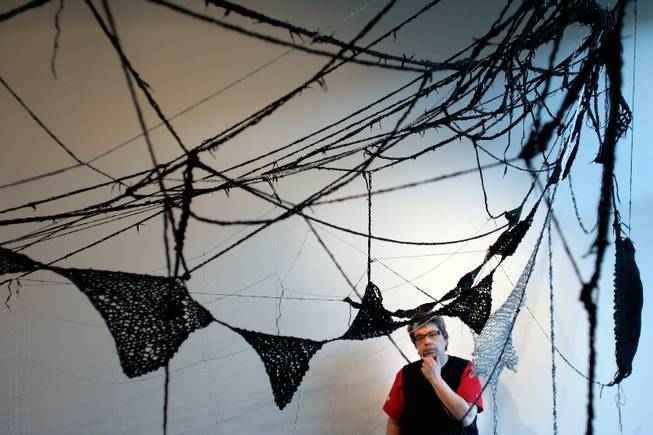
Artist Sheila Pepe installs “Yo Mama,” a site specific work that was a collaboration of her own knitting and crochet work with work from other knitting and crochet artists at the Naomi Arin Contemporary Art gallery in Las Vegas on Thursday, Feb. 19, 2009.
Wednesday, March 4, 2009 | 2 a.m.
Sun Blogs
Beyond the Sun
Sheila Pepe’s installation, “Yo Mama,” at Naomi Arin Contemporary Art, is surprising — not simply because it’s a giant crocheted rendition of a vagina suspended in air, but because of its discussion of feminist art in a city better known for the commercialization of female sexuality.
Crocheting often evokes puritanical, matronly women’s traditions. It’s your mother and her mother and so on. You anticipate scarves and sweaters, not several feet of labia in pinks, reds and purples.
But the sensual, erotic and feminist aren’t new to crocheting — which has been used by artists such as Faith Wilding since the early 1970s.
“Yo Mama,” the third in a series of works that include vaginas, represents “the women who came before us, the women who created repeated work in their own home without fanfare,” Pepe says.
Its almost 7-foot centerpiece invokes a nurturing Earth Mother concept and brings up the often and complicated conversations of sexuality, sexism and feminism on the Strip.
“I wanted to know what happens when you bring this old-school lesbian feminist imagery to Las Vegas in a sex-positive, ‘I love my vagina’ kind of way,” Pepe said while installing the exhibit last month. “The purpose of art is to bring people together and to generate conversation. I like to see what’s possible when reaching across distances.”
Would the same person who takes offense at the selling of women on billboards being driven up and down the Strip be offended by “Yo Mama”?
The installation has a wholesome, handcrafted quality that is a stark contrast to the multimedia, airbrushed, cosmetically enhanced representation of women on the Strip.
“Yo Mama” is erotic, but more than anything, it seems joyous, protective, embracing, cozy and welcoming.
The installation, which fills the entire gallery, hearkens back to generations of women long before women were talking about their sexuality and celebrating it in mainstream works such as Eve Ensler’s “The Vagina Monologues.” A community of knitters from Las Vegas, Los Angeles and San Francisco embedded their names and the names of their mothers and grandmothers in the work through a stitch-count code.
Although the handcrafted work examines issues of womanhood, sexuality, identity, culture and class, the installation is also meant to be fun.
“Humor and imagery are good ways to pull people into a multilayered conversation,” Pepe says, joking that she’s the love child of Eva Hesse and Judy Chicago. Paintings by her artist friends are another element of the show and represent varying ways women have been depicted in art.
Pepe, who is a lesbian, leaves it up to the viewer to interpret her work. Just as religious imagery in artwork doesn’t constitute religious art, “Yo Mama” isn’t lesbian art as much as it is art mostly by and about women with multiple interpretations.
She says she appreciates the way art serves as a way to bridge cultural divides, as when she went to Salt Lake City to work on a project with a former student and other Mormon knitters and crocheters.
Originally from Morristown, N.J., Pepe lives in Brooklyn and refers to herself as an old-school (she was born in 1959), die-hard East Coast resident naive to the rest of the country. She jokes that when arriving in Las Vegas for the installation, she half expected the plane to open onto the tarmac and lead her into a world where Frank and Dean still dominated the small Strip in the desert.
She received her master’s in fine arts from the School of the Museum of Fine Arts in Boston and teaches at Pratt Institute. Crocheting became a part of her two-dimensional works in the mid-1990s. Eventually the crocheted works became their own pieces — abstract modernist drawings in space that are made for the site where they are installed. Her works have been shown in galleries and museums across the country.
Much of her work is autobiographical, representing human labor. Her mother taught her how to crochet. The shoelaces in her works pay homage to her grandfather, an Italian immigrant, who owned a shoe repair shop. Her installation “Tunnel” pays homage to laborers, including her uncle, who helped build the Holland Tunnel, and her aunt, who took the ferry across to the Hudson River to work in a slipper factory. Pepe’s “Red Hook at Bedford Terrace,” recently commissioned for the collection of the Smith College Museum of Art, refers to areas near her Brooklyn apartment and a Massachusetts museum where she worked.


Join the Discussion:
Check this out for a full explanation of our conversion to the LiveFyre commenting system and instructions on how to sign up for an account.
Full comments policy